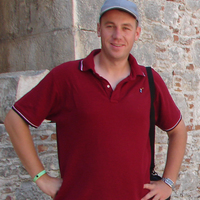- Medieval Archaeology, Pottery (Archaeology), Neolithic Archaeology, Pottery technology and function, Neolithic of the Balkans, Starcevo, and 14 moreArchaeology, Prehistoric Archaeology, Bronze Age Europe (Archaeology), Prehistroy Ironage and Rockarts, archaeology of Macedonia and Thrace, Ancient Weapons and Warfare, Medieval Weapons and Equipment, Ancient and Roman Roads, Medieval roads, Medieval Church History, Mosque Architecture, Ancient Egyptian Military, Ancient Greek and Roman Military Architecture, and Ancient Greek and Roman Military Historyedit
- Slobodan Stojkoski Studied History of art and archaeology at the University "Sv. Kiril i Metodij" in Skopje, Macedonia. Worked at sites through Macedonia in and from different periods ,mostly medieval, but also neolithic, and classical.A researcher working for discovery, preservation restoration and presentation of the material culture of the city of Bitola and Macedonia.edit
Во oвој труд се презентирани резултати од рекогносцирањето на поголем број предисториски локалитети во Пелагонија, а кое беше изведено во рамки на проектот „Тумби во раниот неолит во Пелагонија“ спроведен во периодот од мај до јули 2015... more
Во oвој труд се презентирани резултати од рекогносцирањето на поголем број предисториски локалитети во Пелагонија, а кое беше изведено во рамки на
проектот „Тумби во раниот неолит во Пелагонија“ спроведен во периодот од мај до јули 2015 година. Во трудот се презентирани само дел од вкупно 94 рекогносцирани локалитети, меѓу кои 53 се сосем нови. Некои од овие локалитети се опсежно обработени во трудот, при што се приложени нивната локација, површината што ја зафаќаат, како и моменталната висина. Притоа, се презентирани информации за неколку клучни новооткриени археолошки локалитети од типот „тумби“, карактеристични за пелагонискиот регион, а кои еманираат нова светлина врз неолитот на овој регион. Според добиените податоци може да се заклучи дека повеќето тумби се распоредени околу неколку локални населбински центри кои се истакнуваат преку своите
исклучително големи димензии. Преку најновите мерења и ГИС мапирање на тумбите во централниот дел на Пелагонија се добија мошне прецизни резултати за организацијата на овие населби и нивниот сооднос во повеќе фази на неолитот и подоцнежните предисториски периоди.
проектот „Тумби во раниот неолит во Пелагонија“ спроведен во периодот од мај до јули 2015 година. Во трудот се презентирани само дел од вкупно 94 рекогносцирани локалитети, меѓу кои 53 се сосем нови. Некои од овие локалитети се опсежно обработени во трудот, при што се приложени нивната локација, површината што ја зафаќаат, како и моменталната висина. Притоа, се презентирани информации за неколку клучни новооткриени археолошки локалитети од типот „тумби“, карактеристични за пелагонискиот регион, а кои еманираат нова светлина врз неолитот на овој регион. Според добиените податоци може да се заклучи дека повеќето тумби се распоредени околу неколку локални населбински центри кои се истакнуваат преку своите
исклучително големи димензии. Преку најновите мерења и ГИС мапирање на тумбите во централниот дел на Пелагонија се добија мошне прецизни резултати за организацијата на овие населби и нивниот сооднос во повеќе фази на неолитот и подоцнежните предисториски периоди.
